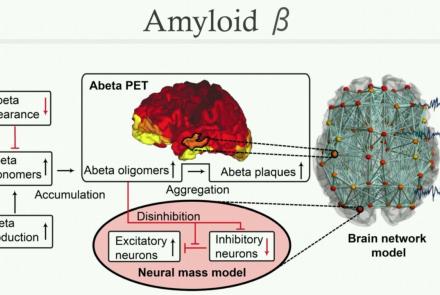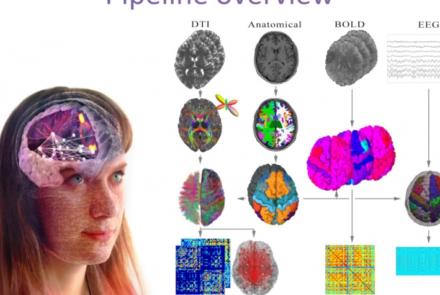This tutorial demonstrates how to use the image processing pipeline with the HBP collab.
Difficulty level: Beginner
Duration: 5:55
Speaker: : M. Schirner, P. Triebkorn, P. Ritter
This tutorial provides instruction on how to use the TVB-NEST toolbox co-simulation in HBP collab.
Difficulty level: Beginner
Duration: 3:11
In this tutorial, you will learn how to use TVB-NEST toolbox on your local computer.
Difficulty level: Beginner
Duration: 2:16
This tutorial provides instruction on how to perform multi-scale simulation of Alzheimer's disease on The Virtual Brain Simulation Platform.
Difficulty level: Beginner
Duration: 29:08
This presentation accompanies the paper entitled: An automated pipeline for constructing personalized virtual brains from multimodal neuroimaging data (see link below to download publication).
Difficulty level: Beginner
Duration: 4:56
This lesson consists of a supplementary video for the publication: Inferring multi-scale neural mechanisms with brain network modelling.
Difficulty level: Beginner
Duration: 3:06
Course:
The Mouse Phenome Database (MPD) provides access to primary experimental trait data, genotypic variation, protocols and analysis tools for mouse genetic studies. Data are contributed by investigators worldwide and represent a broad scope of phenotyping endpoints and disease-related traits in naïve mice and those exposed to drugs, environmental agents or other treatments. MPD ensures rigorous curation of phenotype data and supporting documentation using relevant ontologies and controlled vocabularies. As a repository of curated and integrated data, MPD provides a means to access/re-use baseline data, as well as allows users to identify sensitized backgrounds for making new mouse models with genome editing technologies, analyze trait co-inheritance, benchmark assays in their own laboratories, and many other research applications. MPD’s primary source of funding is NIDA. For this reason, a majority of MPD data is neuro- and behavior-related.
Difficulty level: Beginner
Duration: 55:36
Speaker: : Elissa Chesler
This lecture on model types introduces the advantages of modeling, provide examples of different model types, and explain what modeling is all about.
Difficulty level: Beginner
Duration: 27:48
Speaker: : Gunnar Blohm
Course:
This lecture focuses on how to get from a scientific question to a model using concrete examples. We will present a 10-step practical guide on how to succeed in modeling. This lecture contains links to 2 tutorials, lecture/tutorial slides, suggested reading list, and 3 recorded Q&A sessions.
Difficulty level: Beginner
Duration: 29:52
Speaker: : Megan Peters
Course:
This lecture focuses on the purpose of model fitting, approaches to model fitting, model fitting for linear models, and how to assess the quality and compare model fits. We will present a 10-step practical guide on how to succeed in modeling.
Difficulty level: Beginner
Duration: 26:46
Speaker: : Jan Drugowitsch
This lecture provides an overview of the generalized linear models (GLM) course, originally a part of the Neuromatch Academy (NMA), an interactive online summer school held in 2020. NMA provided participants with experiences spanning from hands-on modeling experience to meta-science interpretation skills across just about everything that could reasonably be included in the label "computational neuroscience".
Difficulty level: Beginner
Duration: 33:58
Speaker: : Cristina Savin
Course:
This lecture introduces the core concepts of dimensionality reduction.
Difficulty level: Beginner
Duration: 31:43
Speaker: : Byron Yu
Course:
This is the first of a series of tutorials on fitting models to data. In this tutorial, we start with simple linear regression, using least squares optimization.
Difficulty level: Beginner
Duration: 6:18
Speaker: : Anqi Wu
Course:
In this tutorial, we will use a different approach to fit linear models that incorporates the random 'noise' in our data.
Difficulty level: Beginner
Duration: 8:00
Speaker: : Anqi Wu
Course:
This tutorial discusses how to gauge how good our estimated model parameters are.
Difficulty level: Beginner
Duration: 5:00
Speaker: : Anqi Wu
Course:
In this tutorial, we will generalize the regression model to incorporate multiple features.
Difficulty level: Beginner
Duration: 7:50
Speaker: : Anqi Wu
Course:
This tutorial teaches users about the bias-variance tradeoff and see it in action using polynomial regression models.
Difficulty level: Beginner
Duration: 6:38
Speaker: : Anqi Wu
Course:
This tutorial covers how to select an appropriate model based on cross-validation methods.
Difficulty level: Beginner
Duration: 5:28
Speaker: : Anqi Wu
This is a tutorial covering Generalized Linear Models (GLMs), which are a fundamental framework for supervised learning. In this tutorial, the objective is to model a retinal ganglion cell spike train by fitting a temporal receptive field: first with a Linear-Gaussian GLM (also known as ordinary least-squares regression model) and then with a Poisson GLM (aka "Linear-Nonlinear-Poisson" model). The data you will be using was published by Uzzell & Chichilnisky 2004.
Difficulty level: Beginner
Duration: 8:09
Speaker: : Anqi Wu
This tutorial covers the implementation of logistic regression, a special case of GLMs used to model binary outcomes. In this tutorial, we will decode a mouse's left/right decisions from spike train data.
Difficulty level: Beginner
Duration: 6:42
Speaker: : Anqi Wu
Topics
- Electroencephalography (EEG) (14)
- Provenance (2)
- Standards and Best Practices (1)
- Brain Medicine (1)
- Artificial Intelligence (1)
- Notebooks (1)
- Event related potential (ERP) (13)
- Digital brain atlasing (3)
- Neuroimaging (16)
- Epilepsy (1)
- Optogenetics (1)
- Neurodevelopmental disorders (1)
- Standards and best practices (1)
- Tools (13)
- Psychology (1)
- (-) Stroke (1)
- (-) Workflows (1)
- protein-protein interactions (1)
- Extracellular signaling (1)
- Assembly 2021 (1)
- Brain-hardware interfaces (12)
- Repositories and science gateways (1)
- Resources (1)
- General neuroscience (5)
- Phenome (1)
- (-) Computational neuroscience (62)
- Statistics (2)
- Computer Science (3)
- Genomics (23)
- Data science (12)
- Open science (14)
- Education (1)
- Neuroethics (1)




















